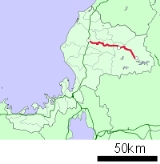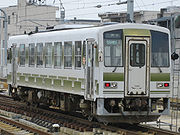
Etsumi-Hoku Line
Encyclopedia
The is a railway line operated by West Japan Railway Company
(JR West) in Fukui Prefecture
, Japan. The line stretches 52.5 km from Echizen-Hanandō Station
in Fukui
to Kuzuryūko Station
in Ōno
with a total of 22 stations. It is also referred to as the .

of ) and Gifu ( province). The plan was not completed; the Etsumi-Hoku Line is the northern half of what would have been the Etsumi Line. The southern half, , became part of the third-sector Nagaragawa Railway.
Legend
West Japan Railway Company
, also referred to as , is one of the Japan Railways Group companies and operates in western Honshū. It has its headquarters in Kita-ku, Osaka.-History:...
(JR West) in Fukui Prefecture
Fukui Prefecture
is a prefecture of Japan located in the Chūbu region on Honshū island. The capital is the city of Fukui.- Prehistory :The Kitadani Dinosaur Quarry, on the Sugiyama River within the city limits of Katsuyama, has yielded the Fukuiraptor kitadaniensis and Fukuisaurus tetoriensis as well as an unnamed...
, Japan. The line stretches 52.5 km from Echizen-Hanandō Station
Echizen-Hanando Station
is a JR West railway station in Fukui, Japan. It is located on the Hokuriku Main Line and the Etsumi-Hoku Line starts from this station.-External links:*...
in Fukui
Fukui, Fukui
is the capital of Fukui Prefecture, Japan. The city is located in the north-central part of the prefecture on the coast of the Sea of Japan.-Demographics:...
to Kuzuryūko Station
Kuzuryuko Station
is a JR West railway station in Ōno, Fukui, Japan. The Etsumi-Hoku Line ends at this station.-External links:...
in Ōno
Ono, Fukui
is a city located in Fukui Prefecture, Japan.As of June 1, 2011, the city has an estimated population of 36,890 with 12,016 households and the density of 42.29 persons per km²...
with a total of 22 stations. It is also referred to as the .
Route data
- Operating Company:
- West Japan Railway CompanyWest Japan Railway Company, also referred to as , is one of the Japan Railways Group companies and operates in western Honshū. It has its headquarters in Kita-ku, Osaka.-History:...
(Services and tracks)
- West Japan Railway Company
- Distance:
- Echizen-Hanandō — Kuzunoryū: 52.5 km / 32.6 mi.
- GaugeRail gaugeTrack gauge or rail gauge is the distance between the inner sides of the heads of the two load bearing rails that make up a single railway line. Sixty percent of the world's railways use a standard gauge of . Wider gauges are called broad gauge; smaller gauges, narrow gauge. Break-of-gauge refers...
: 1067 mm / 3 ft. 6 in. - Stations: 22
- Double-tracking: None
- Electrification: Not electrified
- Railway signallingRailway signallingRailway signalling is a system used to control railway traffic safely, essentially to prevent trains from colliding. Being guided by fixed rails, trains are uniquely susceptible to collision; furthermore, trains cannot stop quickly, and frequently operate at speeds that do not enable them to stop...
:- Echizen-Hanandō — Echizen-Ōno: Simplified automaticAutomatic Block SignalAutomatic Block Signaling, or ABS, is a block system that consists of a series of signals that divide a railway line into a series of blocks and then functions to control the movement of trains between them through automatic signals...
- Echizen-Ōno — Kuzuryū Station: Staff tokenToken (railway signalling)In railway signalling, a token is a physical object which a locomotive driver is required to have or see before entering onto a particular section of single track. The token is clearly endorsed with the name of the section it belongs to...
- Echizen-Hanandō — Echizen-Ōno: Simplified automatic
History
- December 15, 1960: Minami-Fukui — Echizen-Hanandō &mdashl Kadohara section (43.1 km) opens. Freight operations begin between Minami-Fukui — Echizen-Ōno.
- Echizen-Hanandō, Rokujō, Echizen-Tōgō, Ichijōdani, Ichinami, Kowashōzu, Miyama, Echizen-Yakushi, Echizen-Ōmiya, Hakariishi, Ushigahara, Echizen-Ōno, Echizen-Tomida, Shimo-Yuino, Kakigashima, Kadohara stations open.
- May 20, 1964: Asuwa, Echizen-Takada, Echizen-Tano stations open.
- October 15, 1965: Freight operations begin between Echizen-Ōno — Kadohara.
- March 25, 1968: Kita-Ōno Station opens.
- October 1, 1968: Freight operations end at Kadohara Station.
- December 15, 1972: Extension from Kadohara to Kuzuryūko (10.2 km) opens.
- April 1, 1973: Freight operations end between Echizen-Ōno — Echizen-Tomida
- October 1980: Seasonal rapid train "Okuetsu-gō" begins operation.
- November 15, 1982: Freight operations end between Minami-Fukui — Echizen-Ōno, ending freight service on the entire line.
- April 1, 1987: With the breakup and privatization of Japan National Railways, line becomes part of West Japan Railway Company (JR West). Beginning of line moved 800 meters to Echizen-Hanandō Station.
- June 1, 1990: Driver-only operation begins.
- September 1, 1992: Regular rapid service begins.
- September 12, 1995: "Kuzuryū Line" name goes into use.
- September 1, 1997: Seasonal rapid train "Okuetsu-gō" ceases operation.
- March 3, 2001: Regular rapid service ends.
- July 18, 2004: Due to heavy rains, five railway bridges are washed away, forcing operations to stop.
- July 20, 2004: Service restored between Echizen-Ōno — Kuzuryūko.
- September 11, 2004: Service restored between Echizen-Hanandō — Ichijōdani, Miyama — Echizen-Ōno.
- June 30, 2007: Service restored between Ichijōdani — Mihama, allowing full service on the line to resume.

Plan for Etsumi Line
There was originally a plan for an to connect the prefectures of Fukui (the ancient provinceProvinces of Japan
Before the modern prefecture system was established, the land of Japan was divided into tens of kuni , usually known in English as provinces. Each province was divided into gun ....
of ) and Gifu ( province). The plan was not completed; the Etsumi-Hoku Line is the northern half of what would have been the Etsumi Line. The southern half, , became part of the third-sector Nagaragawa Railway.
Stations
- All trains stop at all stations.
- Between and trains run on the Hokuriku Main Line.
- All stations located in Fukui Prefecture.
| Station | Japanese | Distance (km) | Transfers | Tracks | Location | |
|---|---|---|---|---|---|---|
| Between Stations |
From Echizen-Hanandō | |||||
| Hokuriku Main Line | ||||||
| 福井駅 | - | 2.6 | JR West: Hokuriku Main Line Hokuriku Main Line The is a 358.3 kilometer line of the West Japan Railway Company from Maibara Station in Maibara, Shiga to Naoetsu Station in Jōetsu, Niigata. It serves the Hokuriku region on the northern central coast of Honshū, the largest island of Japan, as well as offering connections to the regions of... (for ) Echizen Railway Echizen Railway is a railway company located in Fukui, Fukui Prefecture, Japan. It owns and operates the Katsuyama Eiheiji Line between Fukui and Katsuyama and the Mikuni Awara Line between Fukui and Sakai.-History:... : Katsuyama Eiheiji Line Katsuyama Eiheiji Line The is a railway line operated by Echizen Railway in Fukui Prefecture. The line stretches 27.8 km from the city of Fukui to Katsuyama with a total of 23 stations. It was operated by Keifuku Electric Railway until 2001; Echizen Railway took over the line in 2003.... , Mikuni Awara Line Mikuni Awara Line The is a railway line operated by Echizen Railway in Fukui Prefecture. The line stretches 27.8 km from the city of Fukui to Sakai with a total of 22 stations. It was operated by Keifuku Electric Railway until 2001; Echizen Railway took over the line in 2003.... Fukui Railway: Fukubu Line |
∥ | Fukui Fukui, Fukui is the capital of Fukui Prefecture, Japan. The city is located in the north-central part of the prefecture on the coast of the Sea of Japan.-Demographics:... |
|
| Etsumi-Hoku Line | ||||||
| 越前花堂駅 | 2.6 | 0.0 | JR West: Hokuriku Main Line (for ) | Y | Fukui | |
| 六条駅 | 2.3 | 2.3 | | | |||
| 足羽駅 | 1.4 | 3.7 | | | |||
| 越前東郷駅 | 2.0 | 5.7 | | | |||
| 一乗谷駅 | 2.6 | 8.3 | | | |||
| 越前高田駅 | 3.1 | 11.4 | | | |||
| 市波駅 | 1.2 | 12.6 | | | |||
| 小和清水駅 | 2.0 | 14.6 | | | |||
| 美山駅 | 2.9 | 17.5 | ◇ | |||
| 越前薬師駅 | 2.0 | 19.5 | | | |||
| 越前大宮駅 | 2.7 | 22.2 | | | |||
| 計石駅 | 2.2 | 24.4 | | | |||
| 牛ヶ原駅 | 3.2 | 27.6 | | | Ōno Ono, Fukui is a city located in Fukui Prefecture, Japan.As of June 1, 2011, the city has an estimated population of 36,890 with 12,016 households and the density of 42.29 persons per km²... |
||
| 北大野駅 | 1.8 | 29.4 | | | |||
| 越前大野駅 | 2.0 | 31.4 | ◇ | |||
| 越前田野駅 | 2.9 | 34.3 | | | |||
| 越前富田駅 | 1.4 | 35.7 | | | |||
| 下唯野駅 | 3.1 | 38.8 | | | |||
| 柿ヶ島駅 | 1.0 | 39.8 | | | |||
| 勝原駅 | 2.5 | 42.3 | | | |||
| 越前下山駅 | 6.5 | 48.8 | | | |||
| 九頭竜湖駅 | 3.7 | 52.5 | | | |||
Legend
- ◇ - stations with passing loops
- ∥ - double-tracked section
- |- single-tracked section

